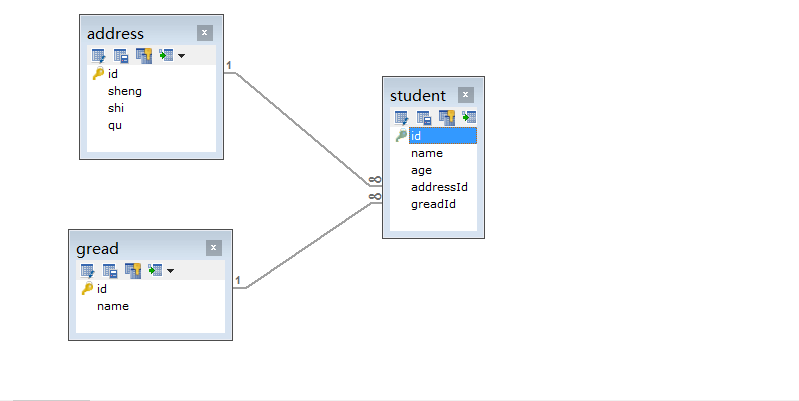年级表,地址表,学生表,通过年级id找对应该年级的学生;通过地址id找对应该地址的学生。这都是典型的一对多的关系。其实反向的还就是正向的一对一。
在这里我们只演示一下通过查找年级,找出对应的学生。

首相我们先构造实体类:
package com.maya.model; import java.util.List; public class Gread { private int id; private String greadName; private List<Student> students;//一个年级对应多个学生
public class Student { private int id; private String name; private int age; private Address address;//一对一 private Gread gread;//同上
2.对应的接口
package com.maya.mappers; import com.maya.model.Gread; public interface GreadMapper { public Gread findById(int id);// }
package com.maya.mappers; import java.util.List; import java.util.Map; import com.maya.model.Student; public interface StudentMapper { //添加 public int add(Student student); //修改 public int update(Student student); //删除 public int delete(int id); //查询全部 public List<Student> findAll(); //查询单个 public Student getOneById(int id); //根据条件查询 public List<Student> findWhere(Map<String, Object>param); //根据年级id查找对应学生 public List<Student> findByGreadId(int greadId); }
3.映射文件
<!DOCTYPE mapper PUBLIC "-//mybatis.org//DTD Mapper 3.0//EN" "http://mybatis.org/dtd/mybatis-3-mapper.dtd"> <mapper namespace="com.maya.mappers.StudentMapper"> <resultMap type="Student" id="StudentResult"> <id property="id" column="id"></id> <result property="name" column="name" /> <result property="age" column="age" />
<association property="address" column="addressId" select="com.maya.mappers.AddressMapper.getById"></association> <!-- property是属性名,column是外键列,select是对应的根据外键id寻找其表中数据的方法 --> <association property="gread" column="greadId" select="com.maya.mappers.GreadMapper.findById"></association>
</resultMap> <select id="findByGreadId" parameterType="int" resultMap="StudentResult"> select * from student where greadId=#{greadId} </select> </mapper>
<?xml version="1.0" encoding="UTF-8"?> <!DOCTYPE mapper PUBLIC "-//mybatis.org//DTD Mapper 3.0//EN" "http://mybatis.org/dtd/mybatis-3-mapper.dtd"> <mapper namespace="com.maya.mappers.GreadMapper"> <resultMap type="Gread" id="GreadResult"> <id property="id" column="id" /> <id property="greadName" column="name" /> <!-- 通过年级的主键去学生表中查找对应的学生,典型的一对多。这里就要用collection标签 --> <collection property="students" column="id" select="com.maya.mappers.StudentMapper.findByGreadId"></collection> <!-- property同样是实体类中的属性名 --> <!--column 注意: 1.一对一时,对应的column是自己的外键 2.这里是一对多的关系,所以在这里对应的column是自己的id主键 --> <!-- select因为这里是通过自己的id去学生表中查找对应的信息,所以写StudentMapper中的根据greadId找学生的方法 --> </resultMap> <select id="findById" parameterType="int" resultMap="GreadResult" > select * from gread where id=#{id} </select> </mapper>
junit测试类:
package com.maya.service; import org.apache.ibatis.session.SqlSession; import org.apache.log4j.Logger; import org.junit.After; import org.junit.Before; import org.junit.Test; import com.maya.mappers.GreadMapper; import com.maya.mappers.StudentMapper; import com.maya.model.Gread; import com.maya.model.Student; import com.maya.util.SqlSessionFactoryUtil; public class OneToManyTest { private static Logger logger=Logger.getLogger(OneToManyTest.class); private SqlSession session=null; private GreadMapper greadMapper=null; private StudentMapper studentMapper=null; @Before public void setUp() throws Exception { session=SqlSessionFactoryUtil.openSession(); greadMapper=session.getMapper(GreadMapper.class); studentMapper=session.getMapper(StudentMapper.class); } @After public void tearDown() throws Exception { session.close(); } @Test public void testOneToMany() { logger.info("通过年级id查询该年级的所有学生,一对多"); Gread gread=greadMapper.findById(4); System.out.println(gread); } @Test public void testOneToManyFanXiang() { logger.info("通过学生id查询所有所在年级和地址,反向一对多,和正向的一对一相同"); Student student=studentMapper.getOneById(6); System.out.println(student); } }